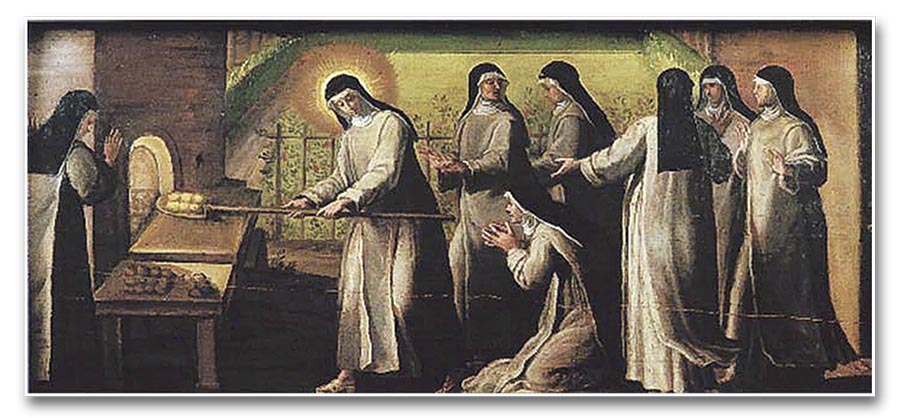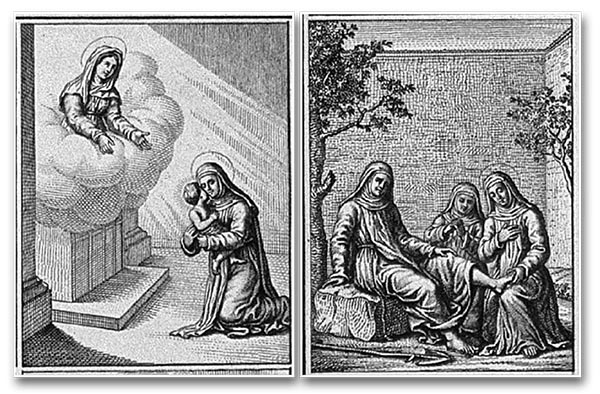The life of this holy abbess invites us to adopt an attitude of deep gratitude for the divine love that descends upon us. Finding no obstacles on our part, the heavenly Father will make His glory shine in our souls!
Visitors to the bustling Italian city of Bologna will find many palaces and historical and buildings there, including those dedicated to its ancient and renowned university. But near the city centre, one is sure to come upon a tiny and charming chapel, where the abbess of the Corpus Domini Monastery has sat for over five centuries.
Kings, clergy and common people have knelt before her, filled with wonder at being able to venerate her up close. Among the long list of illustrious visitors to the chapel, some names draw special attention: St. Charles Borromeo, St. John Bosco and St. Therese of the Child Jesus.
Now, who is this abbess, so benevolent that even today she kindly welcomes all who come to see her? And how is it that she has remained seated there for so many years?
Life at court and entry into religious life
Born in Bologna on September 8, 1413, Catherine was the daughter of Giovanni d’Vigri, a noble gentleman of the Ferrara court, and Benvenuta Mammolini. Intelligent and vivacious, from an early age she was admired by those around her for the generosity and firmness with which she attached herself to the things of Heaven rather than those of the world.
At the age of nine, she went to live at the court of the Marquis of Ferrara, where she became the maid of honour of Princess Margherita d’Este. There she was able to study literature, poetry, music and painting, revealing exceptional artistic gifts, which she put to use with remarkable unpretentiousness, and which explain her designation as patroness of artists.
She was only thirteen when, after the death of her father, she felt drawn to the religious life and joined a community formed by a group of noblewomen of the city. After five years, this group disbanded, but Catherine and some of her companions formed a new group, ruled by the spirituality of St. Francis of Assisi.
Three years later, in 1432, the Provincial of the Franciscans placed them under the first rule of St. Clare. They thus became daughters of Lady Poverty and, as such, it was the lot of young Catherine to carry out the most diverse functions: she was novice mistress, but also porter and baker.
Sister Illuminata Bembo, a companion of the Saint, wrote a picturesque episode that occurred while she fulfilled the latter function. One day, a sermon was being delivered in the monastery which Catherine did not want to miss. So she put the bread in the oven, said “I entrust you to Christ” and then went to hear the sermon, which lasted more than four hours. When she returned to remove the bread, which many sisters imagined would be completely charred, she found it baked to perfection. Realizing that this was a miracle, they all wanted to eat that bread right away!

Likes soldiers on the battlefield
As a mistress of novices, St. Catherine left behind an important treatise on the spiritual life which, centuries later, continues to be useful not only for religious, but for all those who aspire to walk the paths of perfection.
In the very first pages of this book, entitled The Seven Spiritual Weapons, she describes the life of a Christian as follows: “At the beginning and at the end of this battle, one must pass through a stormy sea, that is, through many distressing temptations and fierce battles.”1 And to help us triumph in this struggle, she adds: “I want to give you at the very outset some weapons that will enable you to fight effectively against the cunning of our enemies. But whoever wishes to undertake this battle must never give up, for the enemies never sleep.”2
St. Catherine conceived religious life as that of a soldier on the battlefield who courageously confronts the enemy. Accordingly, she encouraged the members of her community with words such as these: “Beloved sisters, the dowry that Christ Jesus wants to find in each one of you is that you be valiant in battle, that is, strong and steadfast in the fight.”3
However, it was not only her gifts as a pious writer that the novices of Ferrara could appreciate. One of them, who would later take the name Cecilia, afflicted by a terrible temptation and violent attacks of the devil, went to Catherine for help. The novice mistress blessed her and the young woman, feeling immediately free of the infernal enemy, asked the Saint what words she had said. St. Catherine then gave her the formula she had used: “Jesus, Mary, Francis, Clare. May the Lord have mercy on you, bless you and enlighten you, turn His face to you and give you, O Cecilia, His holy peace. So be it!”
A kiss from the Child Jesus
At Christmas 1445, St. Catherine of Bologna asked the superior for permission to spend that night in prayer. She wished to offer a thousand Hail Marys in honour of the Mother of God.
At midnight, Our Lady appeared to her, holding the Child Jesus close to her breast. The Virgin placed the Child in the arms of the Saint, from whose heart overflowed ardent acts of affection and tenderness. The virginal lips of the nun touched the face of the Child, who, in response to the love of his spouse, also gave her a kiss.
Tradition tells us that the white mark which remained on St. Catherine’s incorrupt body indicates the exact spot where Jesus affectionately kissed her. In memory of this fact, to this day the people of Bologna observe the custom of reciting a thousand Hail Marys on Christmas Eve.
On another occasion, she was overcome by a deep and persistent sleepiness during Mass. She struggled with herself to resist the somnolence, and implored divine help. Then, as the priest began to intone the Sanctus, angelic singing began to resound in her ears. So extraordinary was their music that Catherine feared that her soul would leave her body at that moment.

Serenity and confidence in every trial
During that first period in Ferrara, she received many mystical graces, but she also had to endure many spiritual trials. One of the prayers written in the aforementioned book gives us a glimpse of this: “My sweetest Lord Jesus Christ, who by Thine infinite and inexpressible charity suffered cruel torments tied to a pillar, and endured the rough and harsh blows of Thine enemies for my salvation, I beg Thee to grant me such fortitude that with Thy grace I may prevail and endure with patience this and every other battle.”4
Troubled by the temptations of the devil at that time, St. Catherine prayed day and night, asking for divine light to shine upon her, until one night St. Thomas of Canterbury appeared to her, dressed in pontifical vestments. The Saint remained in prayer for some time, after which he lay down and went into a deep sleep. He then awoke and began to pray again, and then approached the Saint and offered her his hands, which she devoutly kissed.
The vision signified that, however great her trials might be, her attitude should always be to pray and to place herself in God’s hands with serenity and confidence. Catherine understood this teaching and from that time on followed it wholeheartedly.
Abbess of a new monastery
When a new monastery of the order was erected in Bologna, St. Catherine was sent there as abbess. With this, she returned to her birthplace, where she would always be remembered.
July 22, 1456 became a historic day for that city. The ecclesiastical and civil authorities, as well as the people, received the foundresses of the new convent with great deference. She would live there for seven years, until her leave-taking from this earth. Together with St. Catherine was her widowed mother, who, being a Franciscan tertiary and infirm, was received by the sisters as a religious.
On the morning of the journey to Bologna, the Saint had awoken feeling so ill that she could not sit upright on her own, and still less walk. Her condition was so serious that it was feared that the new superior would die before she could take up her post…
The route from Ferrara to Bologna at that time was by waterway. When she boarded the ferry, Catherine inexplicably regained her strength and, arriving at the monastery, she attended to countless people for three days on end in such a zealous way that everyone was touched, not imagining that she had just been ill.
As abbess in Bologna, she received a great number of aspirants and worked many miracles. One of them took place in the garden: a sister who was working there cut off her own foot with a violent blow of the hoe. St. Catherine immediately went to the injured religious and with utmost serenity joined the amputated member to her body, tracing the sign of the Cross over it. The gardener was instantly cured, with no scars or any other ill effects of the accident.
Then, looking compassionately at the happy nun, the holy abbess said: “Little daughter, I give you this foot. Take care of it as if it were mine and do it no further harm.”5
Reprieve obtained by her nuns
The penances, labours and struggles against the devil took their toll on her health. St. Catherine was convinced that the moment of her departure from this world was at hand, but her spiritual daughters, although resigned to the divine plan, redoubled their prayers and supplications asking Heaven to leave her a little longer among them.
At that time there lived in the monastery a twelve-year-old girl called Rose Magdalene. She had entered the community two years before, and on account of her innocence, she recognized and admired the virtues of the abbess. For this reason, she sought every possible means to serve her as a nurse, which included washing her feet. She did this with all the reverence of a daughter, and when the service was finished, she held and kissed them with deep veneration.
St. Catherine, in her humility, forbade the girl to repeat the gesture, to which Rose, foreseeing the future, replied, “My mother, you may forbid me to do so while you live on this earth. But you will no longer be able to prevent me when from all parts of the world the faithful will come to visit you and, with profound veneration, will kneel to kiss your feet!”
As St. Catherine’s illness continued to worsen, she received the last Sacraments. In this state, almost in agony, the abbess fell into an ecstasy and had a vision: she found herself in an wonderful garden, adorned with many beautiful flowers. Before her stood a throne as bright as the sun, upon which sat Jesus, flanked by the deacons St. Vincent and St. Lawrence, and surrounded by Angels.
To the right of the throne she saw an Archangel, probably St. Gabriel, who, while playing a stringed instrument, sang: “Et gloria ejus in te videbitur – and his glory will be seen upon you” (Is 60:2). With a gesture of His hand, the Redeemer bade the virgin come forward and explained to her the deepest meaning of these words, referring to herself. He revealed to her, moreover, that although the moment had come for her soul to ascend to Heaven, the prayers of her daughters had obtained for her a little more time on earth.
Coming to herself from this rapture, Catherine regained her vitality. When she told the nuns what she had seen, she imitated the song of the Archangel as best she could, leaving her listeners speechless with admiration.
A gentle passing away after her final sufferings
Towards the end of February 1463, the holy abbess knew that her end was truly approaching. She was stricken with a very high fever, chest pains and an excruciating headache, as well as haemorrhaging.
On March 9, at about two o’clock in the afternoon, she asked that a priest be called to hear her Confession and give her Viaticum and Extreme Unction. She then spoke her last words to her spiritual daughters and gave them the book The Seven Spiritual Weapons, which until then had not been divulged. She was forty-nine years of age, thirty-two of which were spent in consecrated life. Then, repeating the sweet name of Jesus three times, she took flight to meet the Lamb.
While the sisters were burying her body in the monastery cemetery, a mysterious and sweet perfume began to waft from the place, pervading the entire surroundings. There were no trees, herbs or even flowers there, and miraculously the aroma intensified as the days went by. People with incurable diseases began to experience a complete recovery of their health at the site, and three dead children came back to life.

Monastery Chapel, Bologna (Italy)
Obedience even after death
At the time, the custom of the Poor Clares did not allow the sisters to be buried in a coffin. However, the religious, thinking of the regrettable consequences that this would have for the precious relic, asked permission to exhume the body of the abbess on the eighteenth day and deposit it in a vault.
They found it in perfect condition. Only the face had been damaged by the weight of the earth, but after a short time it miraculously returned to normal. After being examined by doctors, the body remained exposed for the devotion of the faithful for six days, and was then placed in a crypt under the altar.
In the year 1475, it was decided that her remains would be placed in a side chapel of the church belonging to the monastery. However, a problem arose: the place where the body was to be laid proved too small for the purpose. The superior of the time did not think twice and ordered St. Catherine to assume a sitting position, a command which the corpse obeyed without hesitation. Having always lived what she had taught, she was able to carry out whatever was required of her, even with her soul separated from her body.
In the middle of the last century, a glass casing was added to protect her. Unfortunately, the body has darkened over the years due to the negligence of the first devotees who burned oil lamps and votive candles very close to the Saint’s body during their prayer vigils.
May God’s glory be seen upon us
In St. Catherine of Bologna, Divine Providence deposited admirable gifts, among which stand out her docility in allowing herself to be loved by God. It was this disposition, accompanied with such devotion, that made it possible for her to so successfully use the outstanding human and spiritual talents with which she had been endowed for the benefit of souls.
Contemplating the life of this holy abbess invites us, before all else, to an attitude of deep gratitude for the divine affection that descends upon each one of us. If He encounters no obstacles on our part, the heavenly Father will transform and sanctify us, making our spirit shine with His, the ultimate end of our existence.
Therefore, we cannot end these lines without uniting ourselves, if only in spirit, to the endless procession of devotees who come to pray at her feet. And in doing so, let us ask that her example and intercession may help us to respond, with a fidelity similar to hers, to the torrents of love that pour forth from the Heart of Jesus. ◊
Notes
1 ST. CATHERINE OF BOLOGNA. Le Sette Armi Spirituali. Bologna: Monasterio del Corpus Domini, 2006, p.3.
2 Idem, ibidem.
3 Idem, p.57.
4 Idem, p.26.
5 CORPUS DOMINI MONASTERY. Santa Caterina da Bologna. Dalla corte estense alla Corte Celeste. Giorgio Barghigiani: Bologna, 2001, p.42.







